Management Report: Impact of Treaty of Waitangi on Business Practices
VerifiedAdded on 2020/04/21
|15
|3523
|159
Report
AI Summary
This report investigates the implications of the Treaty of Waitangi on business management, focusing on the formation of bicultural partnerships and their positive effects on business practices. It explores strategies for integrating these partnerships into business activities, resources, and the assessment of competitive forces and the external environment. The report uses Moana New Zealand as a case study, analyzing the impact of Porter's five forces on the introduction of a new canned fish product and evaluating the role of the Treaty in promoting sustainability and global management within the fishing industry. The analysis also covers the integration of Traditional Ecological Knowledge with Rakiura Maori in southern New Zealand, the sustainability of titi harvests, and the allocation of resources by the Treaty of Waitangi Fisheries Commission, providing insights into the management of fisheries and the dynamics of bicultural partnerships in a global market.
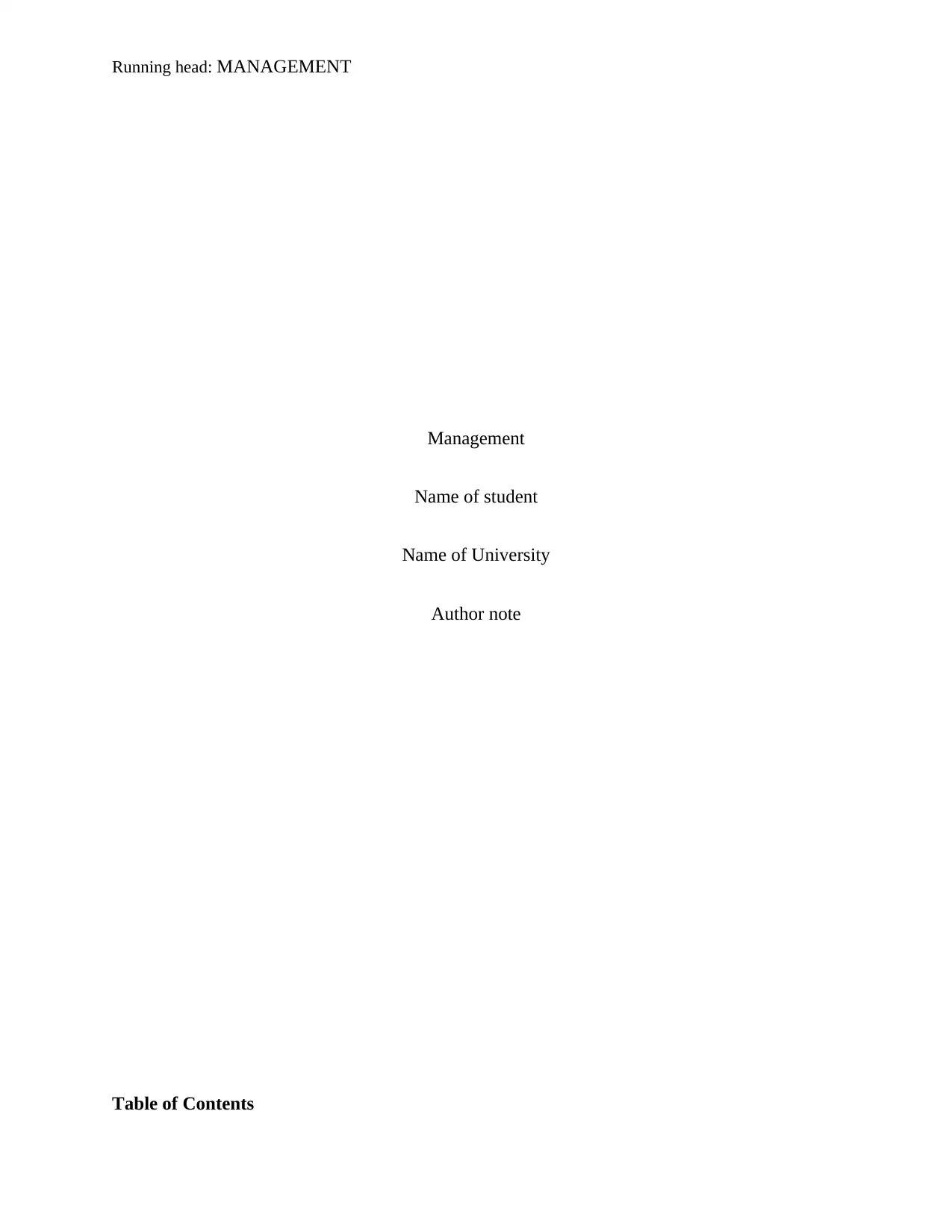
Running head: MANAGEMENT
Management
Name of student
Name of University
Author note
Table of Contents
Management
Name of student
Name of University
Author note
Table of Contents
Paraphrase This Document
Need a fresh take? Get an instant paraphrase of this document with our AI Paraphraser
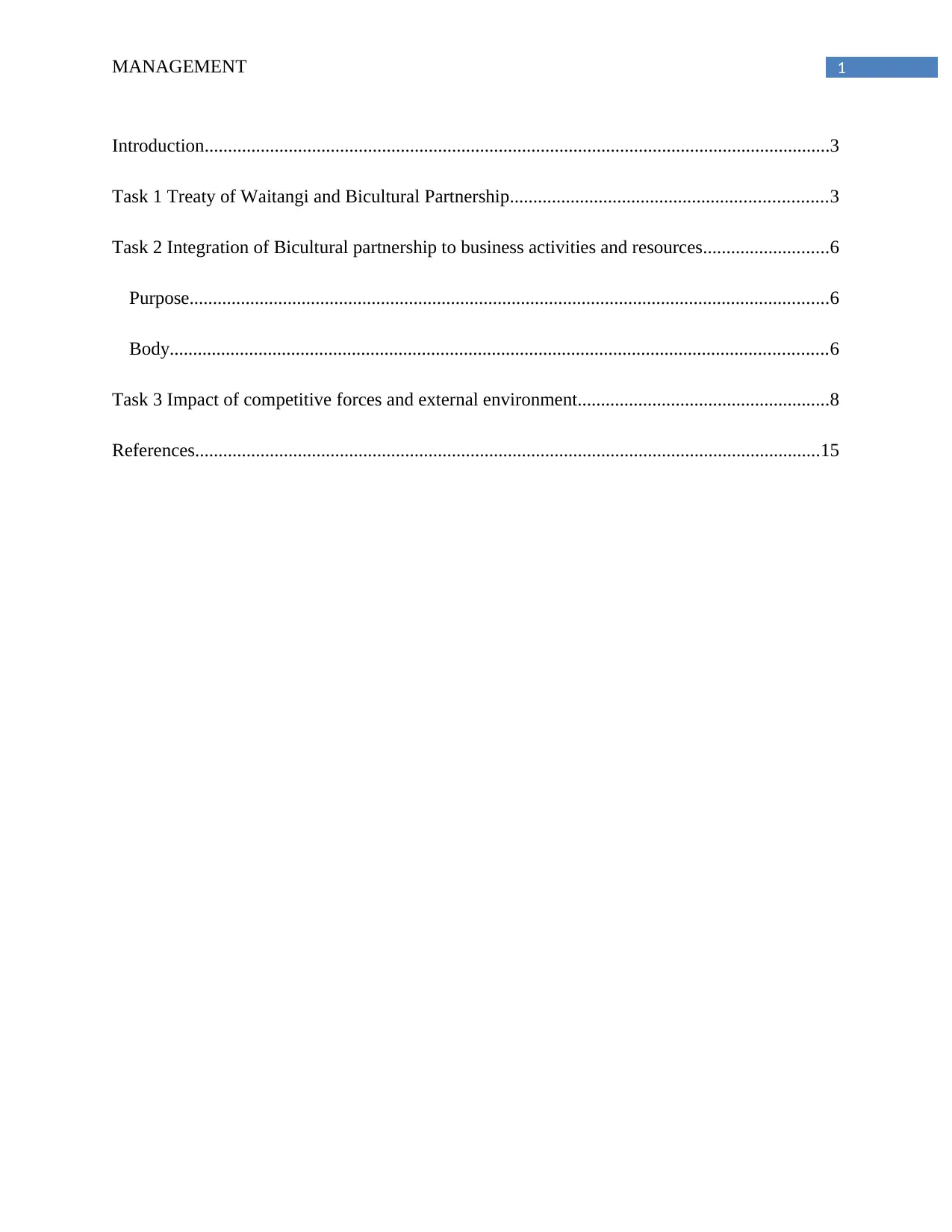
1MANAGEMENT
Introduction......................................................................................................................................3
Task 1 Treaty of Waitangi and Bicultural Partnership....................................................................3
Task 2 Integration of Bicultural partnership to business activities and resources...........................6
Purpose.........................................................................................................................................6
Body.............................................................................................................................................6
Task 3 Impact of competitive forces and external environment......................................................8
References......................................................................................................................................15
Introduction......................................................................................................................................3
Task 1 Treaty of Waitangi and Bicultural Partnership....................................................................3
Task 2 Integration of Bicultural partnership to business activities and resources...........................6
Purpose.........................................................................................................................................6
Body.............................................................................................................................................6
Task 3 Impact of competitive forces and external environment......................................................8
References......................................................................................................................................15
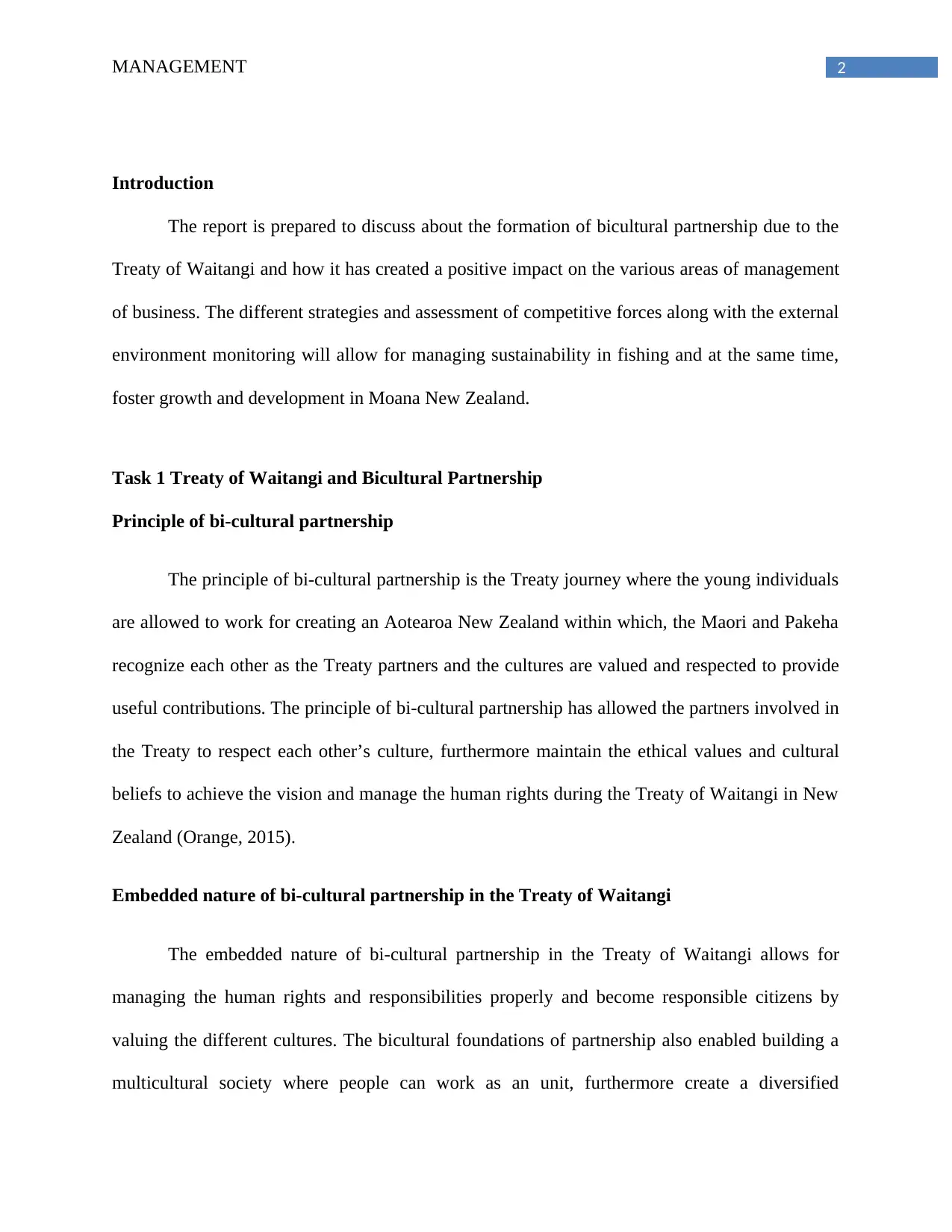
2MANAGEMENT
Introduction
The report is prepared to discuss about the formation of bicultural partnership due to the
Treaty of Waitangi and how it has created a positive impact on the various areas of management
of business. The different strategies and assessment of competitive forces along with the external
environment monitoring will allow for managing sustainability in fishing and at the same time,
foster growth and development in Moana New Zealand.
Task 1 Treaty of Waitangi and Bicultural Partnership
Principle of bi-cultural partnership
The principle of bi-cultural partnership is the Treaty journey where the young individuals
are allowed to work for creating an Aotearoa New Zealand within which, the Maori and Pakeha
recognize each other as the Treaty partners and the cultures are valued and respected to provide
useful contributions. The principle of bi-cultural partnership has allowed the partners involved in
the Treaty to respect each other’s culture, furthermore maintain the ethical values and cultural
beliefs to achieve the vision and manage the human rights during the Treaty of Waitangi in New
Zealand (Orange, 2015).
Embedded nature of bi-cultural partnership in the Treaty of Waitangi
The embedded nature of bi-cultural partnership in the Treaty of Waitangi allows for
managing the human rights and responsibilities properly and become responsible citizens by
valuing the different cultures. The bicultural foundations of partnership also enabled building a
multicultural society where people can work as an unit, furthermore create a diversified
Introduction
The report is prepared to discuss about the formation of bicultural partnership due to the
Treaty of Waitangi and how it has created a positive impact on the various areas of management
of business. The different strategies and assessment of competitive forces along with the external
environment monitoring will allow for managing sustainability in fishing and at the same time,
foster growth and development in Moana New Zealand.
Task 1 Treaty of Waitangi and Bicultural Partnership
Principle of bi-cultural partnership
The principle of bi-cultural partnership is the Treaty journey where the young individuals
are allowed to work for creating an Aotearoa New Zealand within which, the Maori and Pakeha
recognize each other as the Treaty partners and the cultures are valued and respected to provide
useful contributions. The principle of bi-cultural partnership has allowed the partners involved in
the Treaty to respect each other’s culture, furthermore maintain the ethical values and cultural
beliefs to achieve the vision and manage the human rights during the Treaty of Waitangi in New
Zealand (Orange, 2015).
Embedded nature of bi-cultural partnership in the Treaty of Waitangi
The embedded nature of bi-cultural partnership in the Treaty of Waitangi allows for
managing the human rights and responsibilities properly and become responsible citizens by
valuing the different cultures. The bicultural foundations of partnership also enabled building a
multicultural society where people can work as an unit, furthermore create a diversified
⊘ This is a preview!⊘
Do you want full access?
Subscribe today to unlock all pages.

Trusted by 1+ million students worldwide
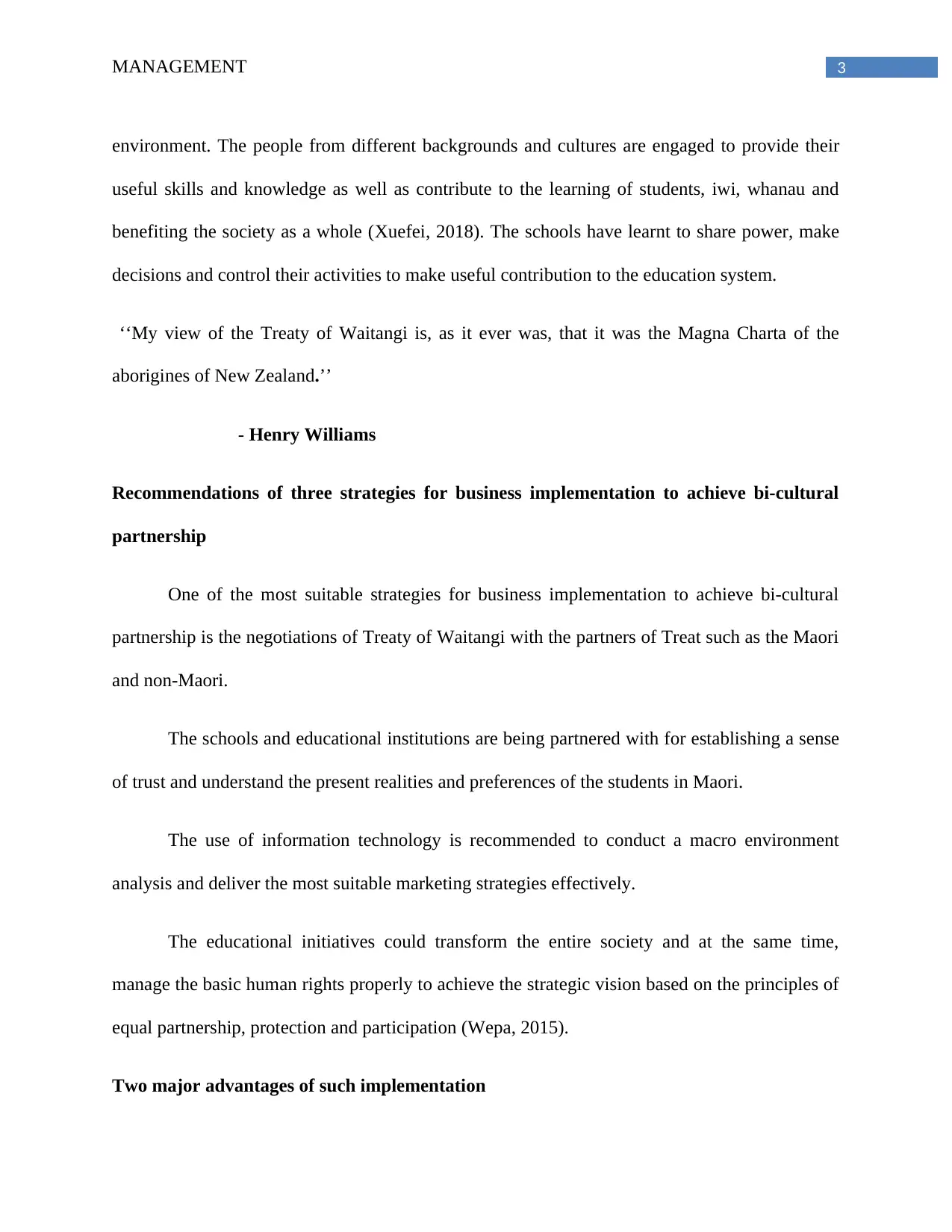
3MANAGEMENT
environment. The people from different backgrounds and cultures are engaged to provide their
useful skills and knowledge as well as contribute to the learning of students, iwi, whanau and
benefiting the society as a whole (Xuefei, 2018). The schools have learnt to share power, make
decisions and control their activities to make useful contribution to the education system.
‘‘My view of the Treaty of Waitangi is, as it ever was, that it was the Magna Charta of the
aborigines of New Zealand.’’
- Henry Williams
Recommendations of three strategies for business implementation to achieve bi-cultural
partnership
One of the most suitable strategies for business implementation to achieve bi-cultural
partnership is the negotiations of Treaty of Waitangi with the partners of Treat such as the Maori
and non-Maori.
The schools and educational institutions are being partnered with for establishing a sense
of trust and understand the present realities and preferences of the students in Maori.
The use of information technology is recommended to conduct a macro environment
analysis and deliver the most suitable marketing strategies effectively.
The educational initiatives could transform the entire society and at the same time,
manage the basic human rights properly to achieve the strategic vision based on the principles of
equal partnership, protection and participation (Wepa, 2015).
Two major advantages of such implementation
environment. The people from different backgrounds and cultures are engaged to provide their
useful skills and knowledge as well as contribute to the learning of students, iwi, whanau and
benefiting the society as a whole (Xuefei, 2018). The schools have learnt to share power, make
decisions and control their activities to make useful contribution to the education system.
‘‘My view of the Treaty of Waitangi is, as it ever was, that it was the Magna Charta of the
aborigines of New Zealand.’’
- Henry Williams
Recommendations of three strategies for business implementation to achieve bi-cultural
partnership
One of the most suitable strategies for business implementation to achieve bi-cultural
partnership is the negotiations of Treaty of Waitangi with the partners of Treat such as the Maori
and non-Maori.
The schools and educational institutions are being partnered with for establishing a sense
of trust and understand the present realities and preferences of the students in Maori.
The use of information technology is recommended to conduct a macro environment
analysis and deliver the most suitable marketing strategies effectively.
The educational initiatives could transform the entire society and at the same time,
manage the basic human rights properly to achieve the strategic vision based on the principles of
equal partnership, protection and participation (Wepa, 2015).
Two major advantages of such implementation
Paraphrase This Document
Need a fresh take? Get an instant paraphrase of this document with our AI Paraphraser
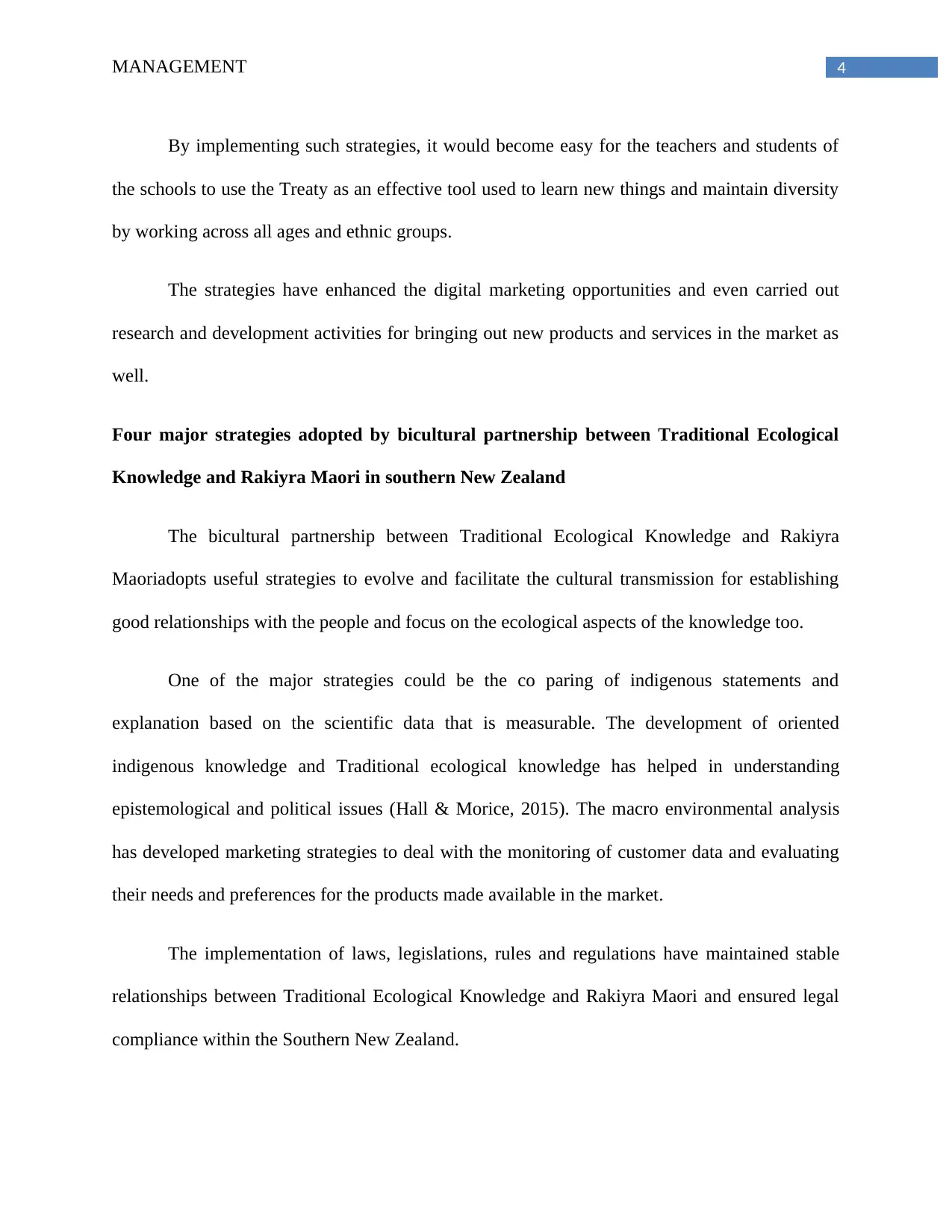
4MANAGEMENT
By implementing such strategies, it would become easy for the teachers and students of
the schools to use the Treaty as an effective tool used to learn new things and maintain diversity
by working across all ages and ethnic groups.
The strategies have enhanced the digital marketing opportunities and even carried out
research and development activities for bringing out new products and services in the market as
well.
Four major strategies adopted by bicultural partnership between Traditional Ecological
Knowledge and Rakiyra Maori in southern New Zealand
The bicultural partnership between Traditional Ecological Knowledge and Rakiyra
Maoriadopts useful strategies to evolve and facilitate the cultural transmission for establishing
good relationships with the people and focus on the ecological aspects of the knowledge too.
One of the major strategies could be the co paring of indigenous statements and
explanation based on the scientific data that is measurable. The development of oriented
indigenous knowledge and Traditional ecological knowledge has helped in understanding
epistemological and political issues (Hall & Morice, 2015). The macro environmental analysis
has developed marketing strategies to deal with the monitoring of customer data and evaluating
their needs and preferences for the products made available in the market.
The implementation of laws, legislations, rules and regulations have maintained stable
relationships between Traditional Ecological Knowledge and Rakiyra Maori and ensured legal
compliance within the Southern New Zealand.
By implementing such strategies, it would become easy for the teachers and students of
the schools to use the Treaty as an effective tool used to learn new things and maintain diversity
by working across all ages and ethnic groups.
The strategies have enhanced the digital marketing opportunities and even carried out
research and development activities for bringing out new products and services in the market as
well.
Four major strategies adopted by bicultural partnership between Traditional Ecological
Knowledge and Rakiyra Maori in southern New Zealand
The bicultural partnership between Traditional Ecological Knowledge and Rakiyra
Maoriadopts useful strategies to evolve and facilitate the cultural transmission for establishing
good relationships with the people and focus on the ecological aspects of the knowledge too.
One of the major strategies could be the co paring of indigenous statements and
explanation based on the scientific data that is measurable. The development of oriented
indigenous knowledge and Traditional ecological knowledge has helped in understanding
epistemological and political issues (Hall & Morice, 2015). The macro environmental analysis
has developed marketing strategies to deal with the monitoring of customer data and evaluating
their needs and preferences for the products made available in the market.
The implementation of laws, legislations, rules and regulations have maintained stable
relationships between Traditional Ecological Knowledge and Rakiyra Maori and ensured legal
compliance within the Southern New Zealand.
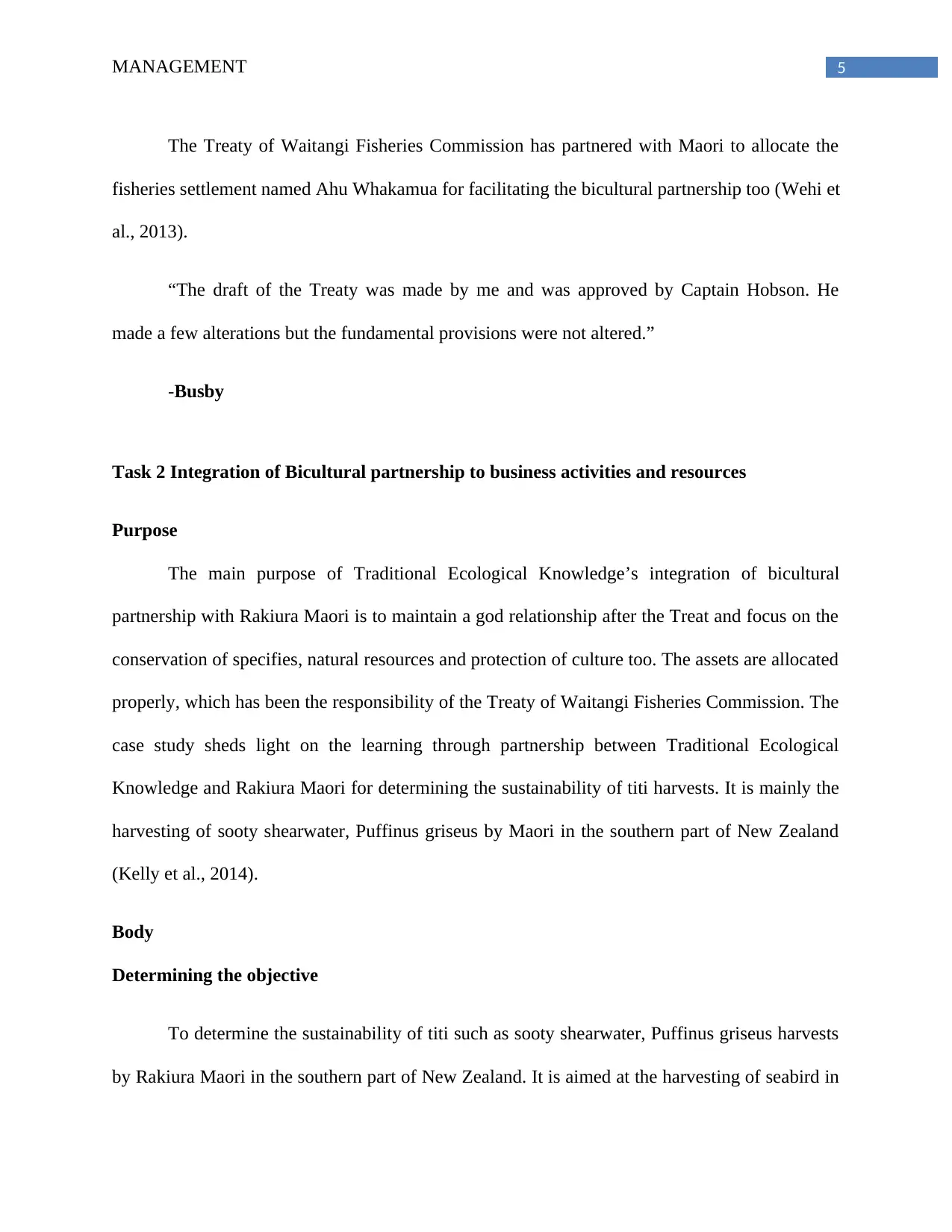
5MANAGEMENT
The Treaty of Waitangi Fisheries Commission has partnered with Maori to allocate the
fisheries settlement named Ahu Whakamua for facilitating the bicultural partnership too (Wehi et
al., 2013).
“The draft of the Treaty was made by me and was approved by Captain Hobson. He
made a few alterations but the fundamental provisions were not altered.”
-Busby
Task 2 Integration of Bicultural partnership to business activities and resources
Purpose
The main purpose of Traditional Ecological Knowledge’s integration of bicultural
partnership with Rakiura Maori is to maintain a god relationship after the Treat and focus on the
conservation of specifies, natural resources and protection of culture too. The assets are allocated
properly, which has been the responsibility of the Treaty of Waitangi Fisheries Commission. The
case study sheds light on the learning through partnership between Traditional Ecological
Knowledge and Rakiura Maori for determining the sustainability of titi harvests. It is mainly the
harvesting of sooty shearwater, Puffinus griseus by Maori in the southern part of New Zealand
(Kelly et al., 2014).
Body
Determining the objective
To determine the sustainability of titi such as sooty shearwater, Puffinus griseus harvests
by Rakiura Maori in the southern part of New Zealand. It is aimed at the harvesting of seabird in
The Treaty of Waitangi Fisheries Commission has partnered with Maori to allocate the
fisheries settlement named Ahu Whakamua for facilitating the bicultural partnership too (Wehi et
al., 2013).
“The draft of the Treaty was made by me and was approved by Captain Hobson. He
made a few alterations but the fundamental provisions were not altered.”
-Busby
Task 2 Integration of Bicultural partnership to business activities and resources
Purpose
The main purpose of Traditional Ecological Knowledge’s integration of bicultural
partnership with Rakiura Maori is to maintain a god relationship after the Treat and focus on the
conservation of specifies, natural resources and protection of culture too. The assets are allocated
properly, which has been the responsibility of the Treaty of Waitangi Fisheries Commission. The
case study sheds light on the learning through partnership between Traditional Ecological
Knowledge and Rakiura Maori for determining the sustainability of titi harvests. It is mainly the
harvesting of sooty shearwater, Puffinus griseus by Maori in the southern part of New Zealand
(Kelly et al., 2014).
Body
Determining the objective
To determine the sustainability of titi such as sooty shearwater, Puffinus griseus harvests
by Rakiura Maori in the southern part of New Zealand. It is aimed at the harvesting of seabird in
⊘ This is a preview!⊘
Do you want full access?
Subscribe today to unlock all pages.

Trusted by 1+ million students worldwide
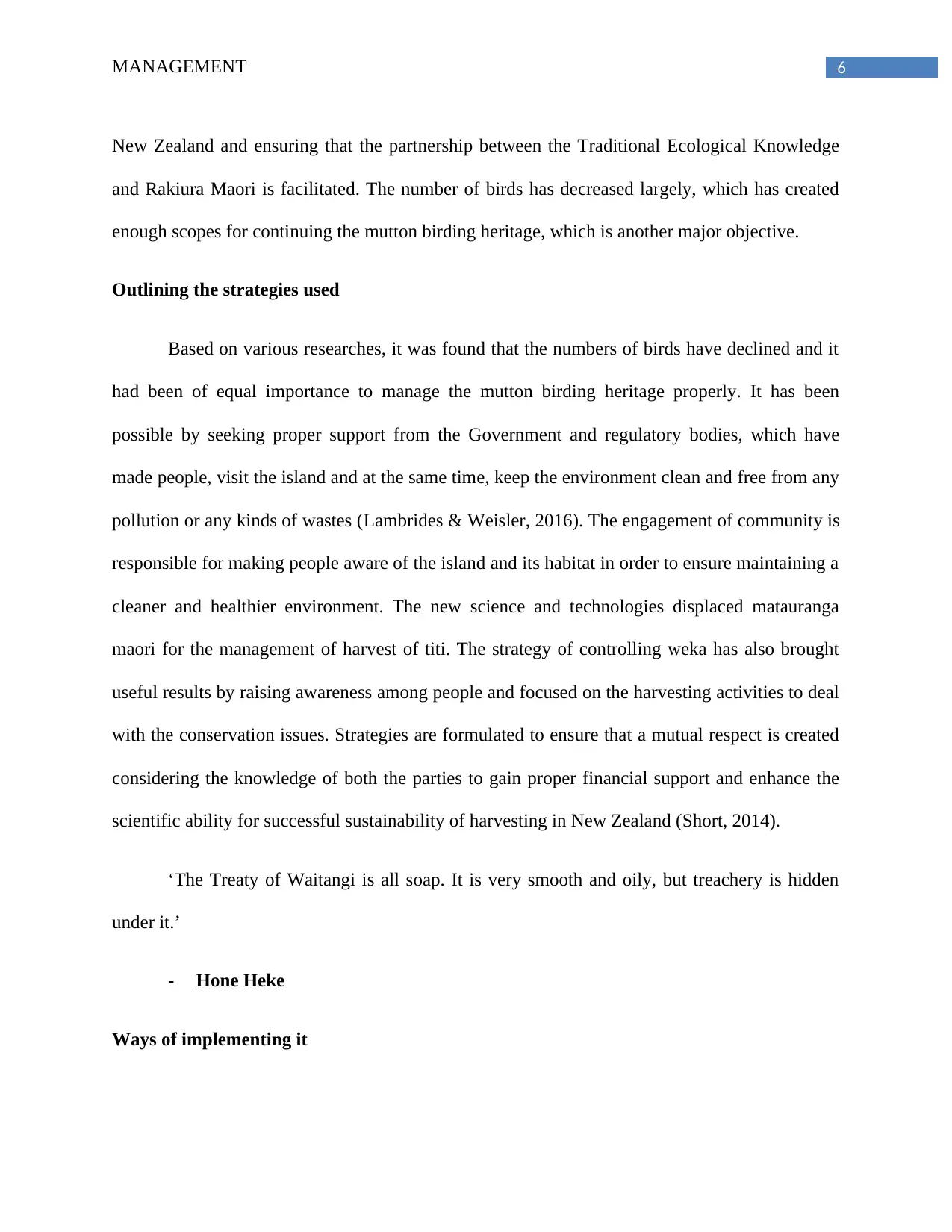
6MANAGEMENT
New Zealand and ensuring that the partnership between the Traditional Ecological Knowledge
and Rakiura Maori is facilitated. The number of birds has decreased largely, which has created
enough scopes for continuing the mutton birding heritage, which is another major objective.
Outlining the strategies used
Based on various researches, it was found that the numbers of birds have declined and it
had been of equal importance to manage the mutton birding heritage properly. It has been
possible by seeking proper support from the Government and regulatory bodies, which have
made people, visit the island and at the same time, keep the environment clean and free from any
pollution or any kinds of wastes (Lambrides & Weisler, 2016). The engagement of community is
responsible for making people aware of the island and its habitat in order to ensure maintaining a
cleaner and healthier environment. The new science and technologies displaced matauranga
maori for the management of harvest of titi. The strategy of controlling weka has also brought
useful results by raising awareness among people and focused on the harvesting activities to deal
with the conservation issues. Strategies are formulated to ensure that a mutual respect is created
considering the knowledge of both the parties to gain proper financial support and enhance the
scientific ability for successful sustainability of harvesting in New Zealand (Short, 2014).
‘The Treaty of Waitangi is all soap. It is very smooth and oily, but treachery is hidden
under it.’
- Hone Heke
Ways of implementing it
New Zealand and ensuring that the partnership between the Traditional Ecological Knowledge
and Rakiura Maori is facilitated. The number of birds has decreased largely, which has created
enough scopes for continuing the mutton birding heritage, which is another major objective.
Outlining the strategies used
Based on various researches, it was found that the numbers of birds have declined and it
had been of equal importance to manage the mutton birding heritage properly. It has been
possible by seeking proper support from the Government and regulatory bodies, which have
made people, visit the island and at the same time, keep the environment clean and free from any
pollution or any kinds of wastes (Lambrides & Weisler, 2016). The engagement of community is
responsible for making people aware of the island and its habitat in order to ensure maintaining a
cleaner and healthier environment. The new science and technologies displaced matauranga
maori for the management of harvest of titi. The strategy of controlling weka has also brought
useful results by raising awareness among people and focused on the harvesting activities to deal
with the conservation issues. Strategies are formulated to ensure that a mutual respect is created
considering the knowledge of both the parties to gain proper financial support and enhance the
scientific ability for successful sustainability of harvesting in New Zealand (Short, 2014).
‘The Treaty of Waitangi is all soap. It is very smooth and oily, but treachery is hidden
under it.’
- Hone Heke
Ways of implementing it
Paraphrase This Document
Need a fresh take? Get an instant paraphrase of this document with our AI Paraphraser
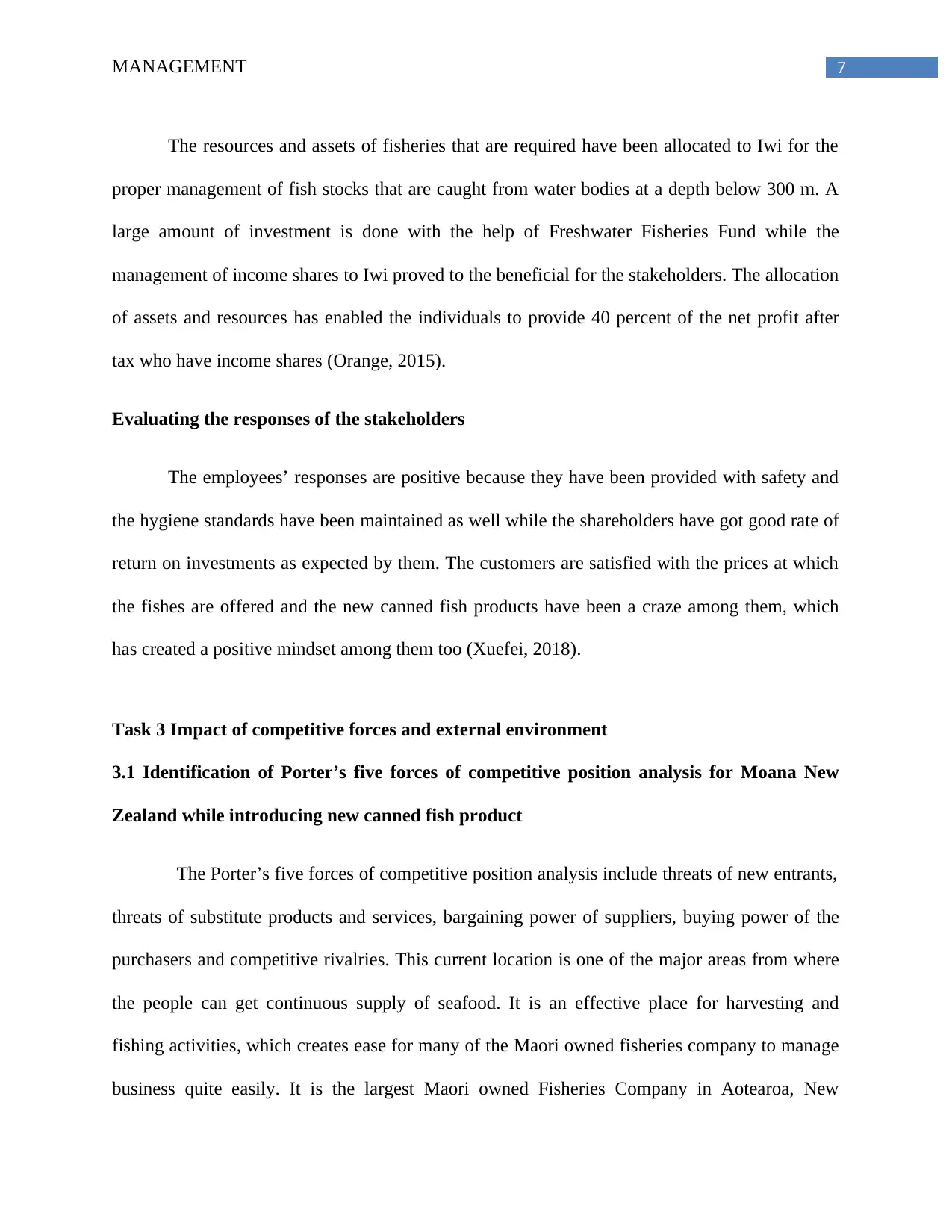
7MANAGEMENT
The resources and assets of fisheries that are required have been allocated to Iwi for the
proper management of fish stocks that are caught from water bodies at a depth below 300 m. A
large amount of investment is done with the help of Freshwater Fisheries Fund while the
management of income shares to Iwi proved to the beneficial for the stakeholders. The allocation
of assets and resources has enabled the individuals to provide 40 percent of the net profit after
tax who have income shares (Orange, 2015).
Evaluating the responses of the stakeholders
The employees’ responses are positive because they have been provided with safety and
the hygiene standards have been maintained as well while the shareholders have got good rate of
return on investments as expected by them. The customers are satisfied with the prices at which
the fishes are offered and the new canned fish products have been a craze among them, which
has created a positive mindset among them too (Xuefei, 2018).
Task 3 Impact of competitive forces and external environment
3.1 Identification of Porter’s five forces of competitive position analysis for Moana New
Zealand while introducing new canned fish product
The Porter’s five forces of competitive position analysis include threats of new entrants,
threats of substitute products and services, bargaining power of suppliers, buying power of the
purchasers and competitive rivalries. This current location is one of the major areas from where
the people can get continuous supply of seafood. It is an effective place for harvesting and
fishing activities, which creates ease for many of the Maori owned fisheries company to manage
business quite easily. It is the largest Maori owned Fisheries Company in Aotearoa, New
The resources and assets of fisheries that are required have been allocated to Iwi for the
proper management of fish stocks that are caught from water bodies at a depth below 300 m. A
large amount of investment is done with the help of Freshwater Fisheries Fund while the
management of income shares to Iwi proved to the beneficial for the stakeholders. The allocation
of assets and resources has enabled the individuals to provide 40 percent of the net profit after
tax who have income shares (Orange, 2015).
Evaluating the responses of the stakeholders
The employees’ responses are positive because they have been provided with safety and
the hygiene standards have been maintained as well while the shareholders have got good rate of
return on investments as expected by them. The customers are satisfied with the prices at which
the fishes are offered and the new canned fish products have been a craze among them, which
has created a positive mindset among them too (Xuefei, 2018).
Task 3 Impact of competitive forces and external environment
3.1 Identification of Porter’s five forces of competitive position analysis for Moana New
Zealand while introducing new canned fish product
The Porter’s five forces of competitive position analysis include threats of new entrants,
threats of substitute products and services, bargaining power of suppliers, buying power of the
purchasers and competitive rivalries. This current location is one of the major areas from where
the people can get continuous supply of seafood. It is an effective place for harvesting and
fishing activities, which creates ease for many of the Maori owned fisheries company to manage
business quite easily. It is the largest Maori owned Fisheries Company in Aotearoa, New
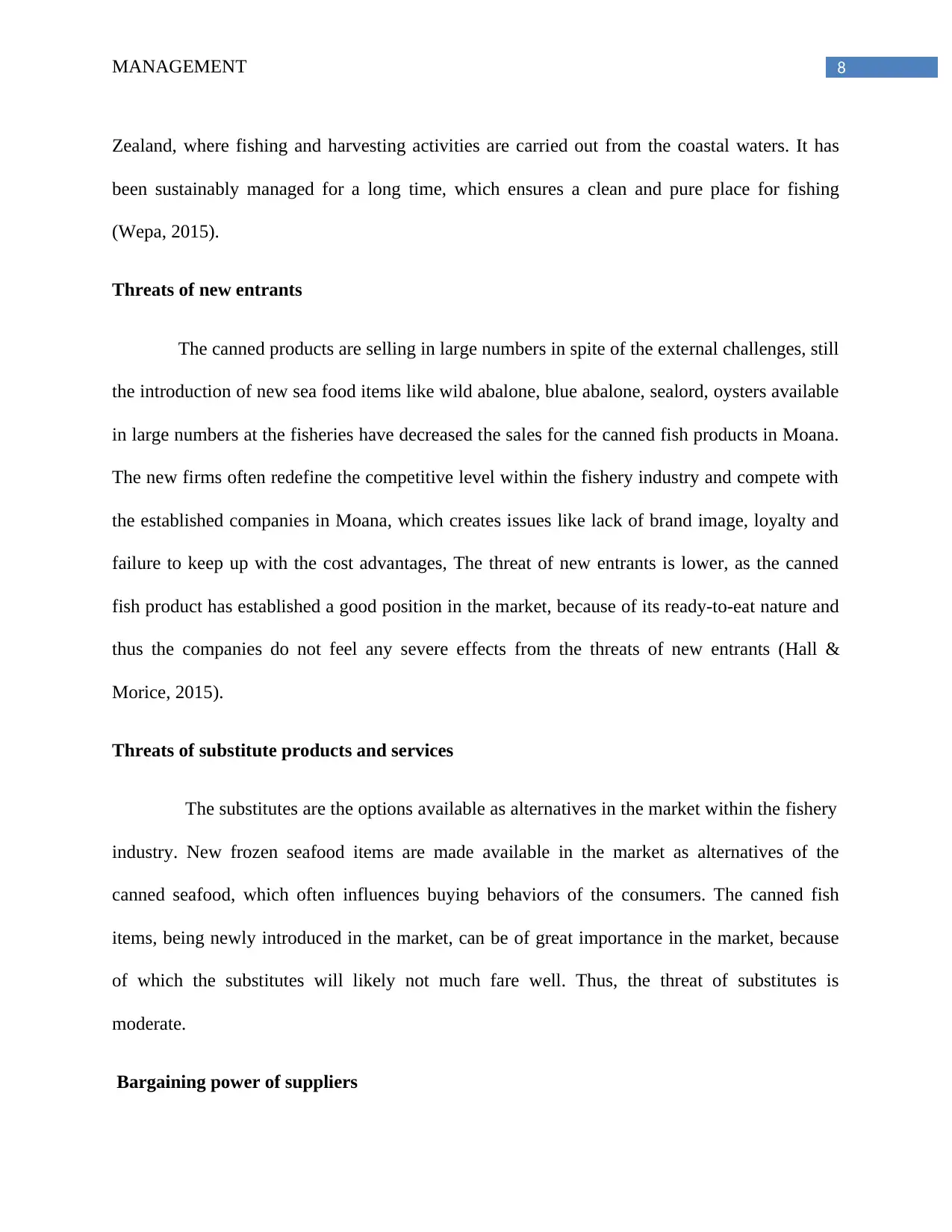
8MANAGEMENT
Zealand, where fishing and harvesting activities are carried out from the coastal waters. It has
been sustainably managed for a long time, which ensures a clean and pure place for fishing
(Wepa, 2015).
Threats of new entrants
The canned products are selling in large numbers in spite of the external challenges, still
the introduction of new sea food items like wild abalone, blue abalone, sealord, oysters available
in large numbers at the fisheries have decreased the sales for the canned fish products in Moana.
The new firms often redefine the competitive level within the fishery industry and compete with
the established companies in Moana, which creates issues like lack of brand image, loyalty and
failure to keep up with the cost advantages, The threat of new entrants is lower, as the canned
fish product has established a good position in the market, because of its ready-to-eat nature and
thus the companies do not feel any severe effects from the threats of new entrants (Hall &
Morice, 2015).
Threats of substitute products and services
The substitutes are the options available as alternatives in the market within the fishery
industry. New frozen seafood items are made available in the market as alternatives of the
canned seafood, which often influences buying behaviors of the consumers. The canned fish
items, being newly introduced in the market, can be of great importance in the market, because
of which the substitutes will likely not much fare well. Thus, the threat of substitutes is
moderate.
Bargaining power of suppliers
Zealand, where fishing and harvesting activities are carried out from the coastal waters. It has
been sustainably managed for a long time, which ensures a clean and pure place for fishing
(Wepa, 2015).
Threats of new entrants
The canned products are selling in large numbers in spite of the external challenges, still
the introduction of new sea food items like wild abalone, blue abalone, sealord, oysters available
in large numbers at the fisheries have decreased the sales for the canned fish products in Moana.
The new firms often redefine the competitive level within the fishery industry and compete with
the established companies in Moana, which creates issues like lack of brand image, loyalty and
failure to keep up with the cost advantages, The threat of new entrants is lower, as the canned
fish product has established a good position in the market, because of its ready-to-eat nature and
thus the companies do not feel any severe effects from the threats of new entrants (Hall &
Morice, 2015).
Threats of substitute products and services
The substitutes are the options available as alternatives in the market within the fishery
industry. New frozen seafood items are made available in the market as alternatives of the
canned seafood, which often influences buying behaviors of the consumers. The canned fish
items, being newly introduced in the market, can be of great importance in the market, because
of which the substitutes will likely not much fare well. Thus, the threat of substitutes is
moderate.
Bargaining power of suppliers
⊘ This is a preview!⊘
Do you want full access?
Subscribe today to unlock all pages.

Trusted by 1+ million students worldwide
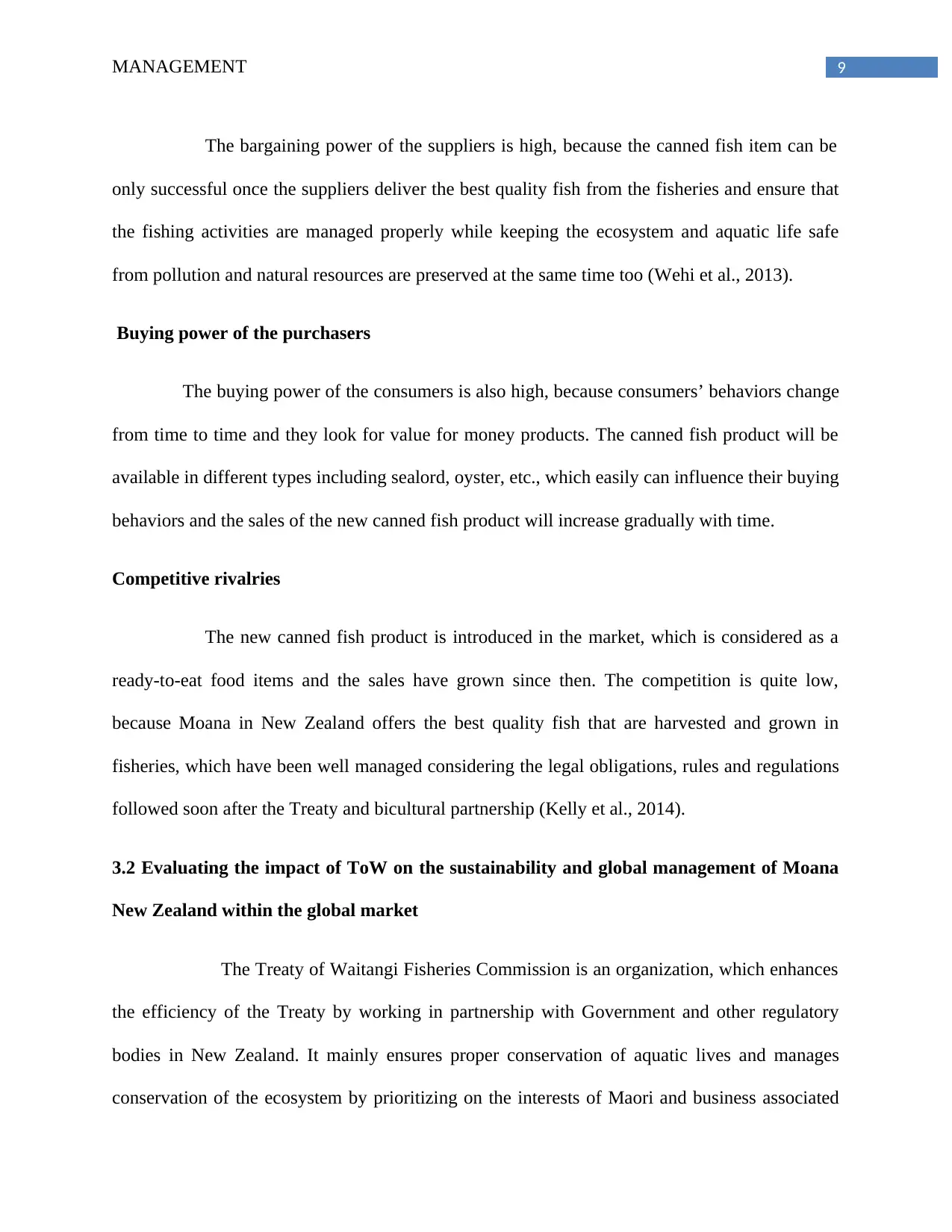
9MANAGEMENT
The bargaining power of the suppliers is high, because the canned fish item can be
only successful once the suppliers deliver the best quality fish from the fisheries and ensure that
the fishing activities are managed properly while keeping the ecosystem and aquatic life safe
from pollution and natural resources are preserved at the same time too (Wehi et al., 2013).
Buying power of the purchasers
The buying power of the consumers is also high, because consumers’ behaviors change
from time to time and they look for value for money products. The canned fish product will be
available in different types including sealord, oyster, etc., which easily can influence their buying
behaviors and the sales of the new canned fish product will increase gradually with time.
Competitive rivalries
The new canned fish product is introduced in the market, which is considered as a
ready-to-eat food items and the sales have grown since then. The competition is quite low,
because Moana in New Zealand offers the best quality fish that are harvested and grown in
fisheries, which have been well managed considering the legal obligations, rules and regulations
followed soon after the Treaty and bicultural partnership (Kelly et al., 2014).
3.2 Evaluating the impact of ToW on the sustainability and global management of Moana
New Zealand within the global market
The Treaty of Waitangi Fisheries Commission is an organization, which enhances
the efficiency of the Treaty by working in partnership with Government and other regulatory
bodies in New Zealand. It mainly ensures proper conservation of aquatic lives and manages
conservation of the ecosystem by prioritizing on the interests of Maori and business associated
The bargaining power of the suppliers is high, because the canned fish item can be
only successful once the suppliers deliver the best quality fish from the fisheries and ensure that
the fishing activities are managed properly while keeping the ecosystem and aquatic life safe
from pollution and natural resources are preserved at the same time too (Wehi et al., 2013).
Buying power of the purchasers
The buying power of the consumers is also high, because consumers’ behaviors change
from time to time and they look for value for money products. The canned fish product will be
available in different types including sealord, oyster, etc., which easily can influence their buying
behaviors and the sales of the new canned fish product will increase gradually with time.
Competitive rivalries
The new canned fish product is introduced in the market, which is considered as a
ready-to-eat food items and the sales have grown since then. The competition is quite low,
because Moana in New Zealand offers the best quality fish that are harvested and grown in
fisheries, which have been well managed considering the legal obligations, rules and regulations
followed soon after the Treaty and bicultural partnership (Kelly et al., 2014).
3.2 Evaluating the impact of ToW on the sustainability and global management of Moana
New Zealand within the global market
The Treaty of Waitangi Fisheries Commission is an organization, which enhances
the efficiency of the Treaty by working in partnership with Government and other regulatory
bodies in New Zealand. It mainly ensures proper conservation of aquatic lives and manages
conservation of the ecosystem by prioritizing on the interests of Maori and business associated
Paraphrase This Document
Need a fresh take? Get an instant paraphrase of this document with our AI Paraphraser
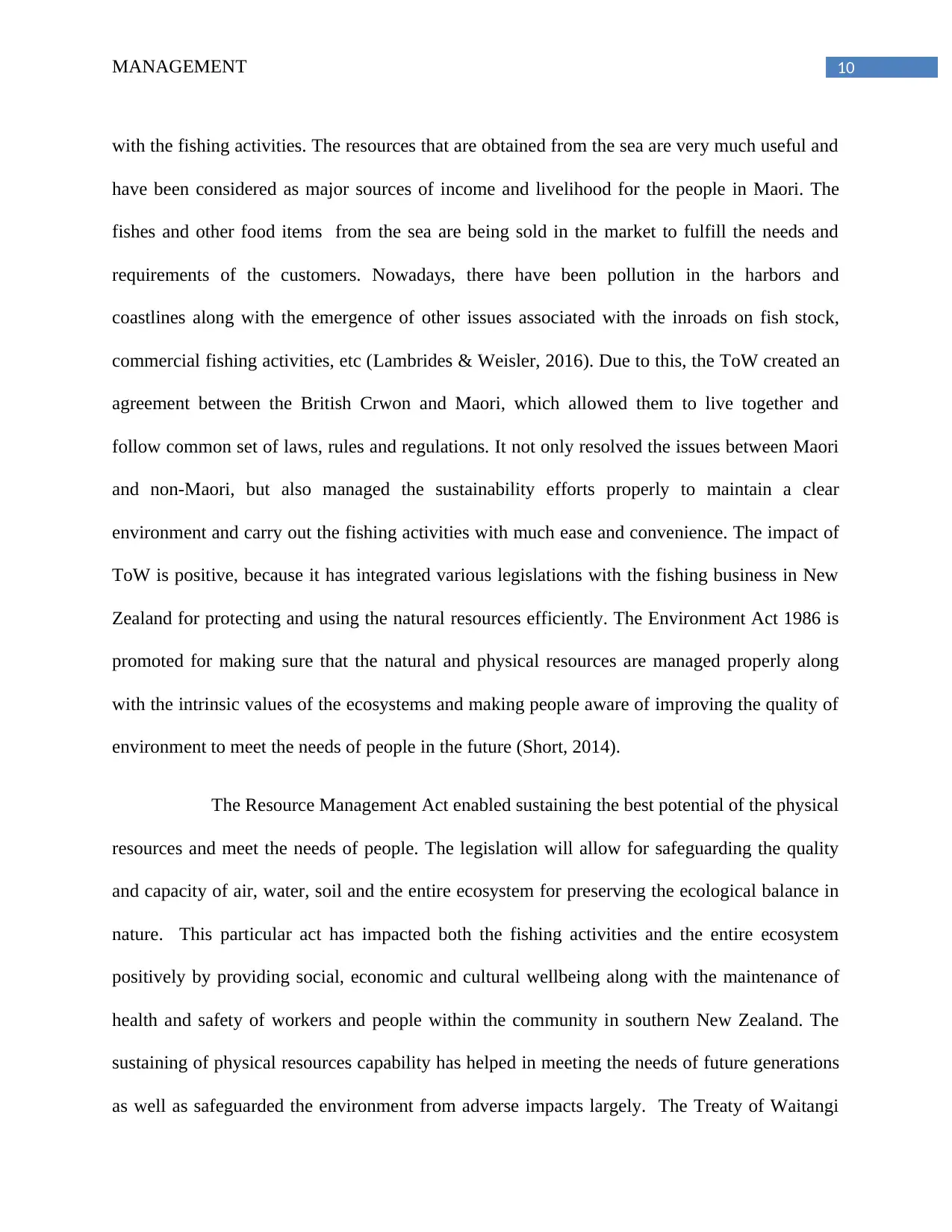
10MANAGEMENT
with the fishing activities. The resources that are obtained from the sea are very much useful and
have been considered as major sources of income and livelihood for the people in Maori. The
fishes and other food items from the sea are being sold in the market to fulfill the needs and
requirements of the customers. Nowadays, there have been pollution in the harbors and
coastlines along with the emergence of other issues associated with the inroads on fish stock,
commercial fishing activities, etc (Lambrides & Weisler, 2016). Due to this, the ToW created an
agreement between the British Crwon and Maori, which allowed them to live together and
follow common set of laws, rules and regulations. It not only resolved the issues between Maori
and non-Maori, but also managed the sustainability efforts properly to maintain a clear
environment and carry out the fishing activities with much ease and convenience. The impact of
ToW is positive, because it has integrated various legislations with the fishing business in New
Zealand for protecting and using the natural resources efficiently. The Environment Act 1986 is
promoted for making sure that the natural and physical resources are managed properly along
with the intrinsic values of the ecosystems and making people aware of improving the quality of
environment to meet the needs of people in the future (Short, 2014).
The Resource Management Act enabled sustaining the best potential of the physical
resources and meet the needs of people. The legislation will allow for safeguarding the quality
and capacity of air, water, soil and the entire ecosystem for preserving the ecological balance in
nature. This particular act has impacted both the fishing activities and the entire ecosystem
positively by providing social, economic and cultural wellbeing along with the maintenance of
health and safety of workers and people within the community in southern New Zealand. The
sustaining of physical resources capability has helped in meeting the needs of future generations
as well as safeguarded the environment from adverse impacts largely. The Treaty of Waitangi
with the fishing activities. The resources that are obtained from the sea are very much useful and
have been considered as major sources of income and livelihood for the people in Maori. The
fishes and other food items from the sea are being sold in the market to fulfill the needs and
requirements of the customers. Nowadays, there have been pollution in the harbors and
coastlines along with the emergence of other issues associated with the inroads on fish stock,
commercial fishing activities, etc (Lambrides & Weisler, 2016). Due to this, the ToW created an
agreement between the British Crwon and Maori, which allowed them to live together and
follow common set of laws, rules and regulations. It not only resolved the issues between Maori
and non-Maori, but also managed the sustainability efforts properly to maintain a clear
environment and carry out the fishing activities with much ease and convenience. The impact of
ToW is positive, because it has integrated various legislations with the fishing business in New
Zealand for protecting and using the natural resources efficiently. The Environment Act 1986 is
promoted for making sure that the natural and physical resources are managed properly along
with the intrinsic values of the ecosystems and making people aware of improving the quality of
environment to meet the needs of people in the future (Short, 2014).
The Resource Management Act enabled sustaining the best potential of the physical
resources and meet the needs of people. The legislation will allow for safeguarding the quality
and capacity of air, water, soil and the entire ecosystem for preserving the ecological balance in
nature. This particular act has impacted both the fishing activities and the entire ecosystem
positively by providing social, economic and cultural wellbeing along with the maintenance of
health and safety of workers and people within the community in southern New Zealand. The
sustaining of physical resources capability has helped in meeting the needs of future generations
as well as safeguarded the environment from adverse impacts largely. The Treaty of Waitangi
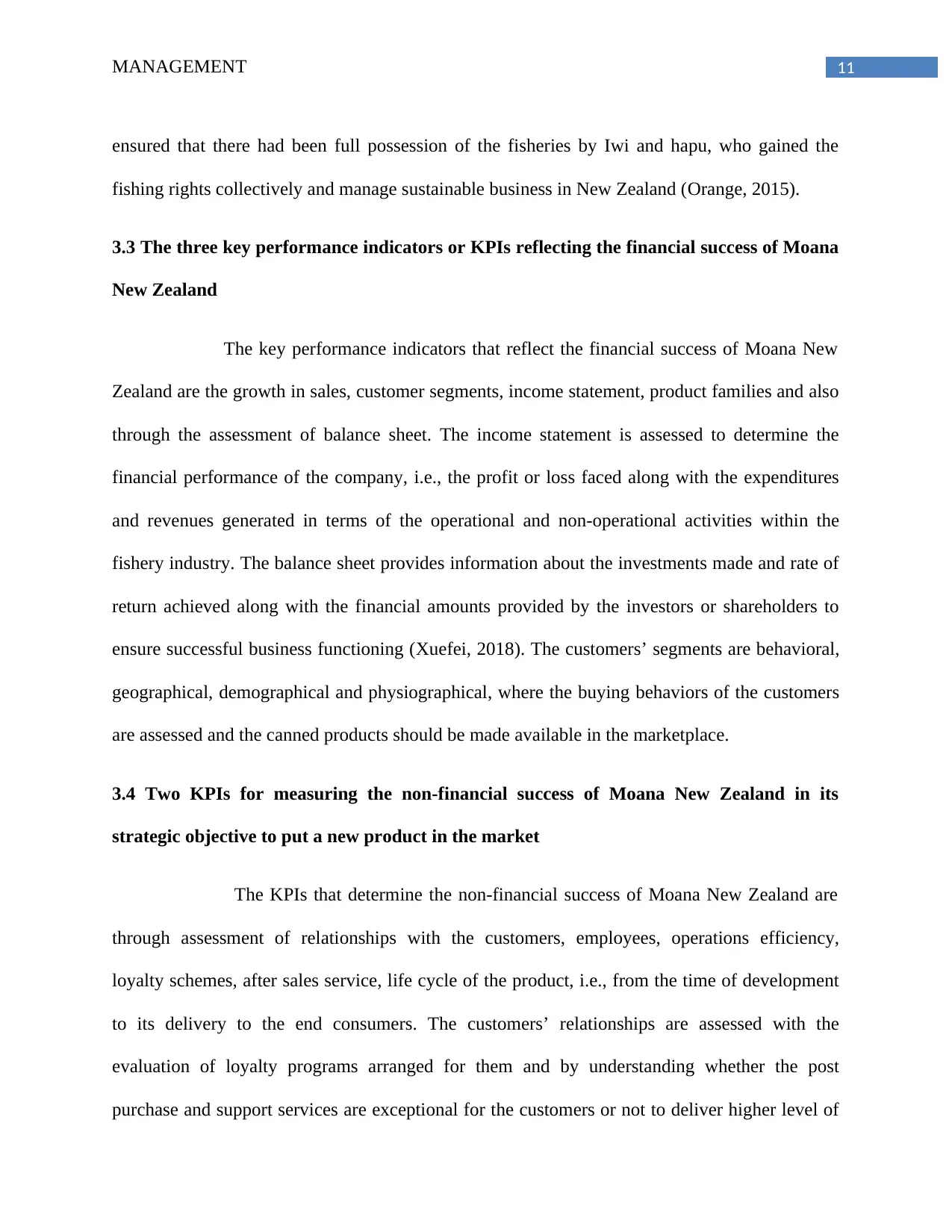
11MANAGEMENT
ensured that there had been full possession of the fisheries by Iwi and hapu, who gained the
fishing rights collectively and manage sustainable business in New Zealand (Orange, 2015).
3.3 The three key performance indicators or KPIs reflecting the financial success of Moana
New Zealand
The key performance indicators that reflect the financial success of Moana New
Zealand are the growth in sales, customer segments, income statement, product families and also
through the assessment of balance sheet. The income statement is assessed to determine the
financial performance of the company, i.e., the profit or loss faced along with the expenditures
and revenues generated in terms of the operational and non-operational activities within the
fishery industry. The balance sheet provides information about the investments made and rate of
return achieved along with the financial amounts provided by the investors or shareholders to
ensure successful business functioning (Xuefei, 2018). The customers’ segments are behavioral,
geographical, demographical and physiographical, where the buying behaviors of the customers
are assessed and the canned products should be made available in the marketplace.
3.4 Two KPIs for measuring the non-financial success of Moana New Zealand in its
strategic objective to put a new product in the market
The KPIs that determine the non-financial success of Moana New Zealand are
through assessment of relationships with the customers, employees, operations efficiency,
loyalty schemes, after sales service, life cycle of the product, i.e., from the time of development
to its delivery to the end consumers. The customers’ relationships are assessed with the
evaluation of loyalty programs arranged for them and by understanding whether the post
purchase and support services are exceptional for the customers or not to deliver higher level of
ensured that there had been full possession of the fisheries by Iwi and hapu, who gained the
fishing rights collectively and manage sustainable business in New Zealand (Orange, 2015).
3.3 The three key performance indicators or KPIs reflecting the financial success of Moana
New Zealand
The key performance indicators that reflect the financial success of Moana New
Zealand are the growth in sales, customer segments, income statement, product families and also
through the assessment of balance sheet. The income statement is assessed to determine the
financial performance of the company, i.e., the profit or loss faced along with the expenditures
and revenues generated in terms of the operational and non-operational activities within the
fishery industry. The balance sheet provides information about the investments made and rate of
return achieved along with the financial amounts provided by the investors or shareholders to
ensure successful business functioning (Xuefei, 2018). The customers’ segments are behavioral,
geographical, demographical and physiographical, where the buying behaviors of the customers
are assessed and the canned products should be made available in the marketplace.
3.4 Two KPIs for measuring the non-financial success of Moana New Zealand in its
strategic objective to put a new product in the market
The KPIs that determine the non-financial success of Moana New Zealand are
through assessment of relationships with the customers, employees, operations efficiency,
loyalty schemes, after sales service, life cycle of the product, i.e., from the time of development
to its delivery to the end consumers. The customers’ relationships are assessed with the
evaluation of loyalty programs arranged for them and by understanding whether the post
purchase and support services are exceptional for the customers or not to deliver higher level of
⊘ This is a preview!⊘
Do you want full access?
Subscribe today to unlock all pages.

Trusted by 1+ million students worldwide
1 out of 15
Related Documents
Your All-in-One AI-Powered Toolkit for Academic Success.
+13062052269
info@desklib.com
Available 24*7 on WhatsApp / Email
![[object Object]](/_next/static/media/star-bottom.7253800d.svg)
Unlock your academic potential
Copyright © 2020–2025 A2Z Services. All Rights Reserved. Developed and managed by ZUCOL.




